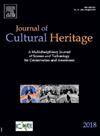The curious case of the green-colored body: A multidisciplinary investigation of a mummy preserved in a copper-rich environment
IF 3.3
2区 综合性期刊
0 ARCHAEOLOGY
引用次数: 0
Abstract
A human skeleton exhibiting extensive green coloration and partial mummification was discovered inside a copper-alloy cist beneath an ancient villa in Bologna (Italy). The preservation of bone and soft tissue, together with the green staining, prompted to infer the diagenetic processes that occurred in this unique case during the post-mortem period, analyzing the chemical and structural alterations of the tissues in a copper-rich burial environment.
A multidisciplinary analytical approach was employed, by combining Fourier Transform Infrared (FTIR) spectroscopy, Raman spectroscopy, and Scanning Electron Microscopy coupled with Energy Dispersive X-ray Spectroscopy (SEM-EDS). These techniques were applied to both stained and unstained samples of bone and skin in order to characterize their organic and inorganic components, identify potential corrosion products—specifically malachite (Cu₂(CO₃)(OH)₂) and pseudomalachite (Cu₅(PO₄)₂(OH)₄)—and evaluate the role of the burial context—particularly the copper container—in shaping the state of preservation.
绿色尸体的奇特案例:对一具保存在富铜环境中的木乃伊的多学科调查
在意大利博洛尼亚一座古别墅下面的铜合金池中发现了一具人类骨骼,显示出大面积的绿色和部分木乃伊化。骨骼和软组织的保存,加上绿色的染色,促使我们推断出这个独特的案例在死后发生的成岩过程,分析了在富含铜的埋葬环境中组织的化学和结构变化。采用多学科分析方法,结合傅里叶变换红外(FTIR)光谱、拉曼光谱、扫描电子显微镜和能量色散x射线光谱(SEM-EDS)。这些技术被应用于染色和未染色的骨骼和皮肤样本,以表征它们的有机和无机成分,识别潜在的腐蚀产物——特别是孔雀石(Cu₂(CO₃)(OH)₂)和假孔雀石(Cu₅(PO₄)₂(OH)₄)——并评估埋葬环境——特别是铜容器——在形成保存状态方面的作用。
本文章由计算机程序翻译,如有差异,请以英文原文为准。
求助全文
约1分钟内获得全文
求助全文
来源期刊

Journal of Cultural Heritage
综合性期刊-材料科学:综合
CiteScore
6.80
自引率
9.70%
发文量
166
审稿时长
52 days
期刊介绍:
The Journal of Cultural Heritage publishes original papers which comprise previously unpublished data and present innovative methods concerning all aspects of science and technology of cultural heritage as well as interpretation and theoretical issues related to preservation.
 求助内容:
求助内容: 应助结果提醒方式:
应助结果提醒方式:


